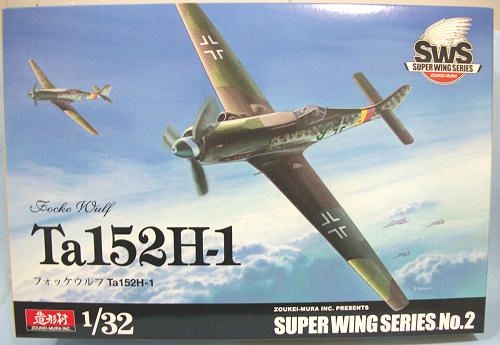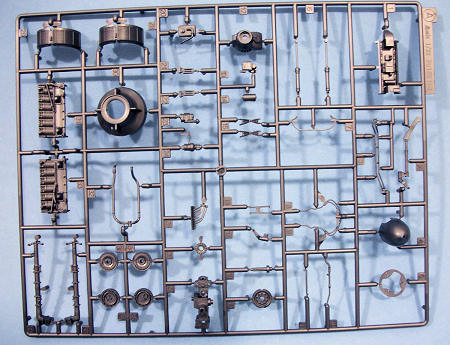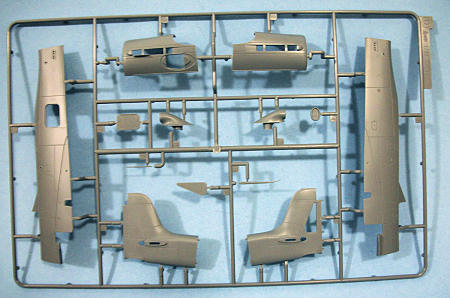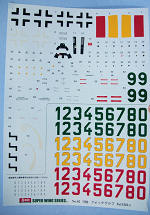
| HISTORY |
| KIT #: | 2 |
| PRICE: | $187.00 MSRP |
| DECALS: | Multiple options |
| REVIEWER: | Tom Cleaver |
| NOTES: |

| HISTORY |
The Ta‑152H was developed from the Ra‑1/Ra‑6, a series of
The Ta‑152H,
with a longer fuselage and greater wingspan
The first Ta‑152H‑0s -
which lacked the wing fuel tanks and MW50 and GM1 systems of the operational
Ta‑152H‑1 -, were in service with Erprobungskommando Ta152 in November
and December 1944, under the command of Hauptmann Bruno Stolle.
Most of the
Ta‑152H‑1s delivered for operational service in February and March 1945 were
equipped with the R11 Rustsatze, which included all‑weather
instrumentation. Approximately 150
Ta‑152H's were produced by the Focke‑Wulf factory at
One pilot who flew the Ta‑152H recalled that, "The flying characteristics of the Ta‑152H put all previous German fighters in the shade. Although I never flew the Me‑262, I would venture to say that the Ta‑152 was by far the superior when it came to dog-fighting with the Allied fighters then in service. In my opinion, there was no better fighter in operational service at the time."
| THE KIT |
 I have to say I find it surprising that an airplane of which fewer than
150 were built and fewer than 10 ever saw squadron service has been as
well-served in plastic and resin as the Ta-152H.
In addition to several kits in 1/72 and one in 1/48, the airplane has
been done three times now in 1/32.
I have to say I find it surprising that an airplane of which fewer than
150 were built and fewer than 10 ever saw squadron service has been as
well-served in plastic and resin as the Ta-152H.
In addition to several kits in 1/72 and one in 1/48, the airplane has
been done three times now in 1/32.
Zoukei-Miura burst on the plastic airplane kit scene earlier this year
with the release of their J7W1 “Shinden,” establishing themselves as a company
releasing super-detailed kits. This
Ta-152H-1 is their second release, and maintains the standard.
I was surprised to notice that the engraved detail is as heavy as it is,
much more so than one would get with a Hasegawa Fw-190.
However, given the way the kit is broken down parts wise, these deeper
panel lines me an
that assembling the model as one complete whole will allow it to have “standard”
panel lines throughout, so one will not have to fill seams to get a uniform
look.
an
that assembling the model as one complete whole will allow it to have “standard”
panel lines throughout, so one will not have to fill seams to get a uniform
look.
Other than the strange parts breakdown, which allows a modeler to build a
“cutaway” model if they so desire, the kit does not look difficult to assemble.
There were in fact fewer parts inside the box than I expected.
The kit provides a nice looking Jumo 213 engine, which can
 form the basis
for a good-looking final result if one wishes to add in the plumbing and the
wires and such. If you assemble it
as a “tarmac” model with everything closed up, the engine will be visible in the
wheel wells and look right without further detailing.
I also like that Zoukei-Miura finally got the shape of the propeller
blades right. They also got the proper “gull” effect to the trailing edge of the
wings, which no one else has done before with any kit.
The seat is provided in two - one with and one without molded-in
seatbelts. The molded-in seatbelts
will look fine if one takes the time to paint them right, while “purists” can
use photo-etch belts.
form the basis
for a good-looking final result if one wishes to add in the plumbing and the
wires and such. If you assemble it
as a “tarmac” model with everything closed up, the engine will be visible in the
wheel wells and look right without further detailing.
I also like that Zoukei-Miura finally got the shape of the propeller
blades right. They also got the proper “gull” effect to the trailing edge of the
wings, which no one else has done before with any kit.
The seat is provided in two - one with and one without molded-in
seatbelts. The molded-in seatbelts
will look fine if one takes the time to paint them right, while “purists” can
use photo-etch belts.
Decals are provided to do every Ta-152H-1 that ever saw service with
JG301, as well as different color plane-in-Staffel numbers and serial numbers to
do any number of “what ifs” should one be interested.
| CONCLUSIONS |
This kit by Zoukei-Miura is definitely the “definitive” kit of the
Ta-152H. It gets everything “right” in terms of shapes and such.
While the panel lines are a bit heavy, this is due to a design decision
that works if a modeler does wish to do a “cutaway.”
Overall this is an excellent kit that looks like it will build up into an
outstanding model. Highly
recommended.
Review kit courtesy of Dave
Cooper at Coopers Models. Order
yours at www.coopersmodels.com
If you would like your product reviewed fairly and quickly, please contact me or see other details in the Note to Contributors.